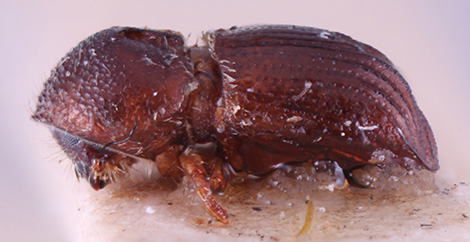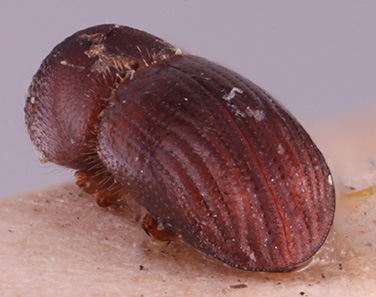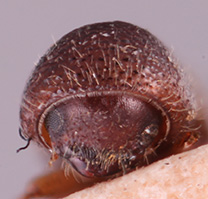Coptodryas elegans
|
Coptodryas elegans syntype lateral; R.K. Osborn |
|
Coptodryas elegans syntype dorsal; R.K. Osborn |
|
Coptodryas elegans syntype declivity; R.K. Osborn |
|
Coptodryas elegans syntype frontal; R.K. Osborn |
Taxonomic history
Xyleborus elegans Sampson, 1923: 288.
Coptodryas elegans (Sampson): Wood, 1989: 171.
Diagnosis
2.1−2.4 mm long (mean = 2.29 mm; n = 5); 2.2−2.4 times as long as wide. This species is distinguished by the dense tuft of setaeseta:
small hair-like or scale-like structure
along the elytralelytral:
pertaining to the elytra
basebase:
point or edge closest to the body; opposite of apex extending to interstriaeinterstria:
extending to interstriaeinterstria:
longitudinal spaces along the elytra between the striae, which is not as<br />
impressed and bear smaller punctures.
 8; body glabrousglabrous:
8; body glabrousglabrous:
smooth, devoid of vestiture
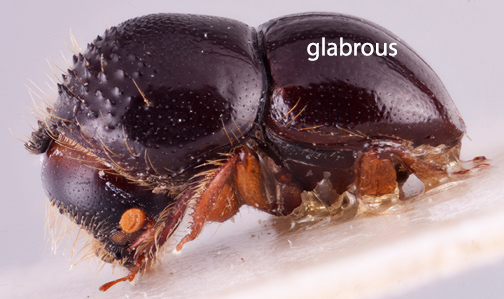 except for pronotalpronotal:
except for pronotalpronotal:
pertaining to the pronotum
and elytralelytral:
pertaining to the elytra
bases; striaestria:
punctures in rows, which may or may not be impressed to make grooves and interstriaeinterstria:
and interstriaeinterstria:
longitudinal spaces along the elytra between the striae, which is not as<br />
impressed and bear smaller punctures.
 uniseriate punctatepunctate:
uniseriate punctatepunctate:
set with fine impressed points, appearing as pin pricks
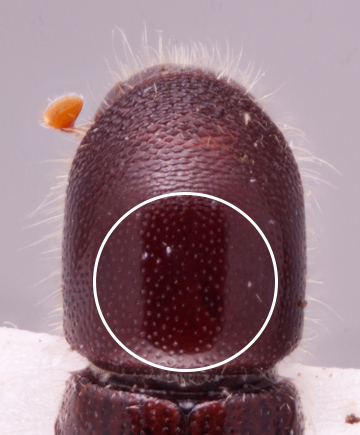 ; elytralelytral:
; elytralelytral:
pertaining to the elytra
discdisc:
the flat central upper surface of any body part (e.g. pronotum and elytra) strongly shiningshining:
strongly shiningshining:
appearing glossy or bright in luster; referring to a surface that is polished and reflects light well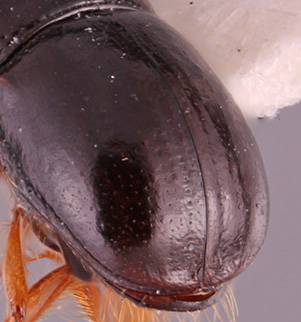 , declivitydeclivity:
, declivitydeclivity:
downward slope of either the pronotum or elytra
 shagreened; declivitydeclivity:
shagreened; declivitydeclivity:
downward slope of either the pronotum or elytra
 bisulcatebisulcate:
bisulcatebisulcate:
pertaining to an elytral declivity with two suci; a sulcus present on each elytron but the suture remains convex
, interstriaeinterstria:
longitudinal spaces along the elytra between the striae, which is not as<br />
impressed and bear smaller punctures.
 2 to striaestria:
2 to striaestria:
punctures in rows, which may or may not be impressed to make grooves 3 weakly to moderately depressed, interstriaeinterstria:
3 weakly to moderately depressed, interstriaeinterstria:
longitudinal spaces along the elytra between the striae, which is not as<br />
impressed and bear smaller punctures.
 4−7 carinate, interstriaeinterstria:
4−7 carinate, interstriaeinterstria:
longitudinal spaces along the elytra between the striae, which is not as<br />
impressed and bear smaller punctures.
 4 moderately tumescent and sharply carinate from basebase:
4 moderately tumescent and sharply carinate from basebase:
point or edge closest to the body; opposite of apex to apicalapex:
to apicalapex:
point or edge furthest from the body; opposite of base
 half; posterolateralposterolateral:
half; posterolateralposterolateral:
relating to end of the side part/portion
 margin carinate to interstriaeinterstria:
margin carinate to interstriaeinterstria:
longitudinal spaces along the elytra between the striae, which is not as<br />
impressed and bear smaller punctures.
 7; protibiaprotibia:
7; protibiaprotibia:
tibia of the first pair of legs
obliquely triangular; pronotumpronotum:
the dorsal surface of the thorax
rounded, robust (type 5) when viewed laterally, and rounded (type 1) when viewed dorsally.
May be confused with
Coptodryas concinna and C. nudipennis
Distribution
China (no specific province), India (Madhya Pradesh, West Bengal), Indonesia (Java), Vietnam
Host plants
recorded from four different families of trees and probably polyphagous (Beaver et al. 2014)
Remarks
Records of this species in Beaver et al. (2014) should be referred to Coptodryas concinna (Beeson).
DNA data
Sequences available for COI and CAD.

